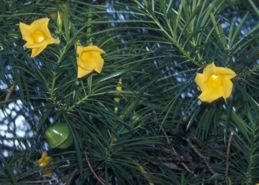“This evening, just after 6.30pm, I stopped at the Tuah Road carpark entrance of Sembawang Park to post a letter in the adjacent post box, and was surprised to see two white cockatoos fly out of a line of tall Yellow Oleander bushes (almost trees, in fact). These bushes are very familiar to me and Wee Sau Cheng as we end our Sembawang Park bird census there, three times a year, always adding to our tally of sunbirds who are invariably present and partaking of the nectar of the flowers. But we have never seen cockatoos there.
“The cockatoos were the size of Goffins/Tanimbar cockatoos, but one of them had a backward sloping crest, not usual in Goffins, so maybe something different. And one of them was holding a green Yellow Oleander (Thevetia peruviana) fruit in its foot. I did not have binos with me, and anyway they tucked themselves away out of sight in a tall tree and the light was rapidly failing. So I went and inspected the tarmac path under the Yellow Oleander.
“There were a number of green fruits on the ground – some had several curved marks (beak marks?) on them but were still whole; some had been bitten into from the outside but were still essentially whole. But most of what I inspected were halves of a split fruit, also with two or three curved marks on the outside. In some halves the pithy inside was a relatively undistinguished mass and totally untouched. In other halves there was a lot of pith but also curved spaces where I presume a developing seed, or part of it, had been pulled out.
“I also picked up one fruit that had been eaten into from the side to expose half of a completely formed seed, with the other half seed firmly embedded in the other half of the fruit, which just had a thin wall of pith (flesh).
“I did not see any fully ripe yellow or black fruits on the ground at all.
“My interest was aroused because I have always known Yellow Oleander to be very poisonous. Indeed, on confirming from a couple of Yeow Chin’s books when I returned home, just one seed can apparently kill a child, and several will finish off an adult. And every other bit of the plant is poisonous too. Presuming that the birds were ingesting something, and were not just enjoying the tactile pleasure of getting into the unripe fruits and spitting out bits of developing seeds (a possibility – we should not presume birds to eat something until we actually see it go down the throat) why are they not dead?
“Well, perhaps they are! Maybe the birds were a pair of recent escapees looking desperately for food and not very sure of what was good. Maybe I witnessed the “error” part of “trial and error”! It has to happen sometimes!
“Or maybe they can cope with the poison? Or maybe the developing/forming seeds go through a stage where they do not contain the poison, whilst the fully-formed seed does have poison. This would explain the abandoned fully formed seed that I found.
“If there is some food value for cockatoos in Yellow Oleander, then it will be a case of alien (introduced) cockatoos being able to enjoy an alien (introduced) fruit, which has, so far as I know, not been exploited by any local bird species.
“Anybody know anything on this? Maybe cockatoos are well known to cope with poisons and it’s nothing new.
“Presuming it is of interest, I will try to pass by from time to time to see if the pair are (a) alive, and (b) actually eating the seeds. But I have a lot of papers to mark. If any of the roving bird photographers are nearby over the next few days and can check it out, that would be good.”
Margie Hall
14th November 2008










4 Responses
Have observed more than 20 species (the number is in fact high) of birds consuming the Yellow oleander fruits or probing its flowers for nectar. The birds include three species of bulbul,three species of myna/starling,two species of crow,two species of sunbird,greater coucal,babblers,Koel etc. Have also seen squirrels consuming fallen fruits. Many bees visit the flowers…
Obviously the fruits are not poisonous to these birds. Thanks for the information, Sanjeev.